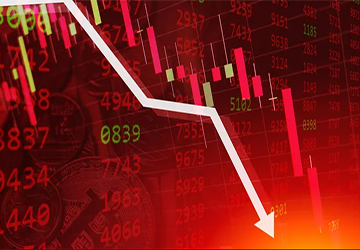Investing in the stock market can be a rollercoaster ride, with highs and lows that can make your head spin. While everyone loves a bull market where stocks are rising, there are times when the market takes a bearish turn.
A bear market is a period of declining stock prices, and it's crucial to recognize the warning signs to protect your investments. This article briefly summarizes the top 10 warning signs of a bearish stock market trend.
1.Persistent Declines in Stock Prices
The most obvious sign of a bear market is when stock prices consistently drop over an extended period. This isn't just a few bad days; it's a sustained decrease in value. Investors begin to lose confidence, and the market sentiment turns negative.
Keep an eye on major stock indices like the S&P 500 or Dow Jones Industrial Average – if they're on a downward trend, it's a red flag. Additionally, consider setting stop-loss orders on your investments to limit potential losses during such periods.

2.Rising Unemployment Rates
The health of the economy and the stock market are closely linked. One of the warning signs of a bear market is a rise in unemployment rates. When people lose their jobs or fear job loss, they tend to spend less, which can negatively impact corporate profits and, in turn, stock prices.
Pay attention to employment reports as an indicator of economic health. Moreover, consider diversifying your investments across different sectors to mitigate the impact of economic downturns.
3.Earnings Decline
Corporate earnings are the lifeblood of the stock market. When companies report declining profits, it clearly shows a bearish trend. Investors closely watch earnings reports, and stock prices are likely to fall if they consistently disappoint.
Keep an eye on the quarterly earnings reports of companies you're invested in or interested in. Additionally, consider adopting a value investing approach, focusing on companies with solid fundamentals and a history of weathering economic storms.
4.High Valuations
Sometimes, stocks become overvalued during a bull market, setting the stage for a bear market. When the price of a stock is significantly higher than its intrinsic value, it's a sign of a bubble bound to burst.
Watch out for companies with sky-high price-to-earnings ratios and consider whether their valuations are sustainable. Furthermore, maintain a watchlist of undervalued stocks you can purchase when prices become more attractive.
5.Declining Consumer Confidence
Consumer spending drives a significant portion of the economy. When consumers become less confident about the future, they're more likely to save and cut back on spending. This can lead to reduced corporate revenues and falling stock prices.
Please pay attention to consumer confidence surveys and how they trend over time. Furthermore, consider maintaining an emergency fund to stabilize financially during uncertain economic times.
6.Tightening Monetary Policy
Central banks, like the Federal Reserve in the United States, significantly influence the stock market. When central banks start raising interest rates or reducing economic stimulus measures, it can signal a bearish trend.
Higher interest rates make borrowing more expensive for businesses and individuals, potentially slowing economic growth. Stay updated on central bank policies and their potential impact on the market. Also, consider diversifying your investments globally to reduce exposure to a single country's monetary policies.

7.Geopolitical Events and Uncertainty
Political instability and global conflicts can profoundly impact the stock market. Investors tend to be cautious when there's uncertainty about the future due to geopolitical events.
Unexpected events like trade wars or political crises can trigger a bear market. Stay informed about international developments that could impact the market, and consider adding defensive assets like gold to your portfolio as a hedge against geopolitical risks.
8.High Levels of Debt
Excessive debt can be a ticking time bomb for both individuals and companies. When debt levels become unsustainable, it can lead to financial distress, bankruptcies, and a bearish stock market. Keep an eye on debt-to-equity ratios and leverage levels of companies in your investment portfolio.
Moreover, regularly review your financial situation to ensure you're not over-leveraged and prepared for potential economic downturns.
9.Volatility and Fear
A bearish market often comes with increased market volatility. Investors become jittery, and fear can drive rapid and sharp market declines. Monitoring market volatility through indices like the VIX (Volatility Index) can help you gauge the market's anxiety level.
Consider having a well-defined investment strategy with precise entry and exit points to help you stay calm and rational during heightened volatility.
10.Technical Indicators
Lastly, consider using technical analysis to spot signs of a bearish trend. Technical indicators, such as moving averages or chart patterns, can provide insights into market sentiment. For example, if a stock's price crosses below its 200-day moving average, it may signal a bearish trend.
Incorporate technical analysis into your investment decision-making process, but always complement it with fundamental analysis for a more comprehensive view of your investments.
Navigating a Bear Market: Tips and Strategies
Here are some practical tips and strategies to help you navigate a bearish stock market:
1. Stay Informed and Remain Calm: Knowledge is your best ally. Keep yourself updated on the latest news and developments in the financial markets, but don't let emotions drive your decisions. Panic selling often leads to losses. Maintain a long-term perspective and stay calm.
2. Reassess Your Portfolio: Take a close look at your investment portfolio. Consider reallocating your assets to reduce risk. Diversification is key. Spread your investments across different asset classes, such as stocks, bonds, and cash, to minimize losses during a market downturn.
Conclusion
Recognizing the warning signs of a bearish stock market trend is essential for protecting your investments. Bear markets can be challenging, but being prepared and proactive can help you navigate them. Keep an eye on these ten warning signs, stay informed about economic and geopolitical developments, and consider diversifying your investments to reduce risk. Remember, while bear markets are a part of the investing cycle, they can also present opportunities for long-term investors to buy quality assets at lower prices.





